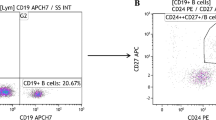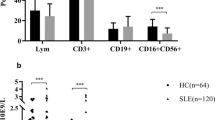Abstract
B cells are essential players in the pathogenic mechanisms of systemic lupus erythematosus (SLE). Although CD5+ B cells have been considered to play a paradoxical role in preventing, rather than inducing autoimmunity, there is no consensus agreement about the proportions of CD5+ B cells population in SLE patients. So, the aim of the present study was to assess blood concentration of CD5+ B cells in patients with SLE and to evaluate their relationship with disease activity and organ damage. We recruited 100 SLE patients and 100 healthy control subjects. Based on SLE disease activity index (SLEDAI), patients were divided into two groups: active SLE (n = 50) and inactive SLE (n = 50). SLE was active when SLEDAI was ≥ 4. The expression of CD5+ B cells was evaluated using flow cytometry to measure the proportions and absolute numbers of the cells. The proportions of CD5+ B cells of total lymphocytes were significantly lower in SLE patients versus controls (4.1 ± 3.9 vs 10.8 ± 5.2%, P = <0.001). CD5+ B cells were significantly decreased in active SLE patients (3.1 ± 2.7%) in comparison to inactive patients (5.2 ± 3.7%) (P = 0.013). CD5+ B cells correlated positively with C3 (r = 0.328, P = 0.020) and C4 (r = 0.355, P = 0.011). CD5+ B cells were significantly decreased in SLE patients compared to healthy controls and they were significantly decreased in active SLE patients in comparison to inactive ones.


Similar content being viewed by others
References
D'Cruz D, Khamashta M, Hughes G (2007) Systemic lupus erythematosus. Lancet 369:587–596
Mageed R, Prud'homme G (2003) Immunopathology and the gene therapy of lupus. Gene Ther 10:861–874
Lino AC, Dörner T, Bar-Or A et al (2016) Cytokine-producing B cells: a translational view on their roles in human and mouse autoimmune diseases. Immunol Rev 269:130–144
Dorner T, Lipsky PE (2016) Beyond pan-B-cell-directed therapy—new avenues and insights into the pathogenesis of SLE. Nat Rev Rheumatol 12:645–657
Chan OT, Madaio MP, Shlomchik MJ (1999) The central and multiple roles of B cells in lupus pathogenesis. Immunol Rev 169:107–121
La Cava A, Fang CJ, Singh RP et al (2005) Manipulation of immune regulation in systemic lupus erythematosus. Autoimmun Rev 4:515–519
Odendahl M, Jacobi A, Hansen A et al (2000) Disturbed peripheral B lymphocyte homeostasis in systemic lupus erythematosus. J Immunol 165:5970–5979
Jacobi AM, Odendahl M, Reiter K et al (2003) Correlation between circulating CD27high plasma cells and disease activity in patients with systemic lupus erythematosus. Arthritis Rheum 48:1332–1342
Chang NH, McKenzie T, Bonventi G et al (2008) Expanded population of activated antigen-engaged cells within the naive B cell compartment of patients with systemic lupus erythematosus. J Immunol 180:1276–1284
Boumsell L, Coppin H, Pham D et al (1980) An antigen shared by a human T cell subset and B cell chronic lymphocytic leukemic cells. Distribution on normal and malignant lymphoid cells. J Exp Med 152:229–234
Caligaris-Cappio F, Gobbi M, Bofill M et al (1982) Infrequent normal B lymphocytes express features of B-chronic lymphocytic leukemia. J Exp Med 155:623–628
Kantor A (1991) A new nomenclature for B cells. Immunol Today 12:388
Kasaian MT, Ikematsu H, Casali P (1992) Identification and analysis of a novel human surface CD5- B lymphocyte subset producing natural antibodies. J Immunol 148:2690–2702
Youinou P (2011) Renaudineau Y.CD5 Expression in B cells from patients with systemic lupus erythematosus. Crit Rev Immunol 31:31–42
Smith HR (1990) Olson RR.CD5+ B lymphocytes in systemic lupus erythematosus and rheumatoid arthritis. J Rheumatol 17:833–835
Casali P, Burastero SE, Balow JE et al (1989) High-affinity antibodies to ssDNA are produced by CD-B cells in systemic lupus erythematosus patients. J Immunol 143:3476–3483
Victor KD, Randen I, Thompson K et al (1991) Rheumatoid factors isolated from patients with autoimmune disorders are derived from germline genes distinct from those encoding the Wa, Po, and Bla cross-reactive idiotypes. J Clin Invest 87:1603–1613
Youinou P, Renaudineau Y (2007) The paradox of CD5-expressing B cells in systemic lupus erythematosus. Autoimmun Rev 7:149–154
Hochberg MC (1997) Updating the American College of Rheumatology revised criteria for the classification of systemic lupus erythematosus. Arthritis Rheum 40:1725
Mosca M, Bombardieri S (2006) Assessing remission in systemic lupus erythematosus. Clin Exp Rheumatol 24:S-99–S104
Ruiz-Irastorza G, Khamashta MA, Castellino G et al (2001) Systemic lupus erythematosus. Lancet 357:1027–1032
Renaudineau Y, Pers JO, Bendaoud B et al (2004) Dysfunctional B cells in systemic lupus erythematosus. Autoimmun Rev 3:516–523
Hippen K, Tze L (2000) Behrens T.CD5 maintains tolerance in anergic B cells. J Exp Med 191:883–890
Korganow AS, Knapp AM, Nehme-Schuster H et al (2010) Peripheral B cell abnormalities in patients with systemic lupus erythematosus in quiescent phase: decreased memory B cells and membrane CD19 expression. J Autoimmun 34:426–434
Vernino LA, Pisetsky DS, Lipsky PE (1992) Analysis of the expression of CD5 by human B cells and correlation with functional activity. Cell Immunol 139:185–197
Garaud S, Le Dantec C, Jousse-Joulin S et al (2009) IL-6 modulates CD5 expression in B cells from patients with lupus by regulating DNA methylation. J Immunol 182:5623–5632
Markeljevic J, Batinic D, Uzarevic B et al (1994) Peripheral blood CD5+ B cell subset in the remission phase of systemic connective tissue diseases. J Rheumatol 21:2225–2230
Bohm I (2004) Increased peripheral blood B-cells expressing the CD5 molecules in association to autoantibodies in patients with lupus erythematosus and evidence to selectively down-modulate them. Biomed Pharmacother = Biomed Pharmacother 58:338–343
Duan B, Morel L (2006) Role of B-1a cells in autoimmunity. Autoimmun Rev 5:403–408
Bouaziz J, Yanaba K, Tedder T (2008) Regulatory B cells as inhibitors of immune responses and inflammation. Immunol Rev 224:201–214
Becker H, Weber C, Storch S et al (1990) Relationship between CD5+ B lymphocytes and the activity of systemic autoimmunity. Clin Immunol Immunopathol 56:219–225
Ebo D, DeClerck LS, Bridts CH et al (1994) Expression of CD5 and CD23 on B cells of patients with rheumatoid arthritis, systemic lupus erythematosus and Sjogren's syndrome. Relationship with disease activity and treatment. In Vivo (Athens, Greece) 8:577–580
Gupta R, Jain P, Deo SV et al (2004) Flow cytometric analysis of CD5+ B cells: a frame of reference for minimal residual disease analysis in chronic lymphocytic leukemia. Am J Clin Pathol 121:368–372
Ahearn JM, Fischer MB, Croix D et al (1996) Disruption of the Cr2 locus results in a reduction in B-1a cells and in an impaired B cell response to T-dependent antigen. Immunity 4:251–262
Reid RR, Woodcock S, Shimabukuro-Vornhagen A et al (2002) Functional activity of natural antibody is altered in Cr2-deficient mice. J Immunol 169:5433–5440
Carroll MC (2004) The complement system in B cell regulation. Mol Immunol 41:141–146
Author information
Authors and Affiliations
Corresponding author
Ethics declarations
Disclosures
None.
Rights and permissions
About this article
Cite this article
Omar, H.H., Nasef, S.I., Omar, H.H. et al. CD5+ B lymphocytes in systemic lupus erythematosus patients: relation to disease activity. Clin Rheumatol 36, 2719–2726 (2017). https://doi.org/10.1007/s10067-017-3818-z
Received:
Revised:
Accepted:
Published:
Issue Date:
DOI: https://doi.org/10.1007/s10067-017-3818-z




